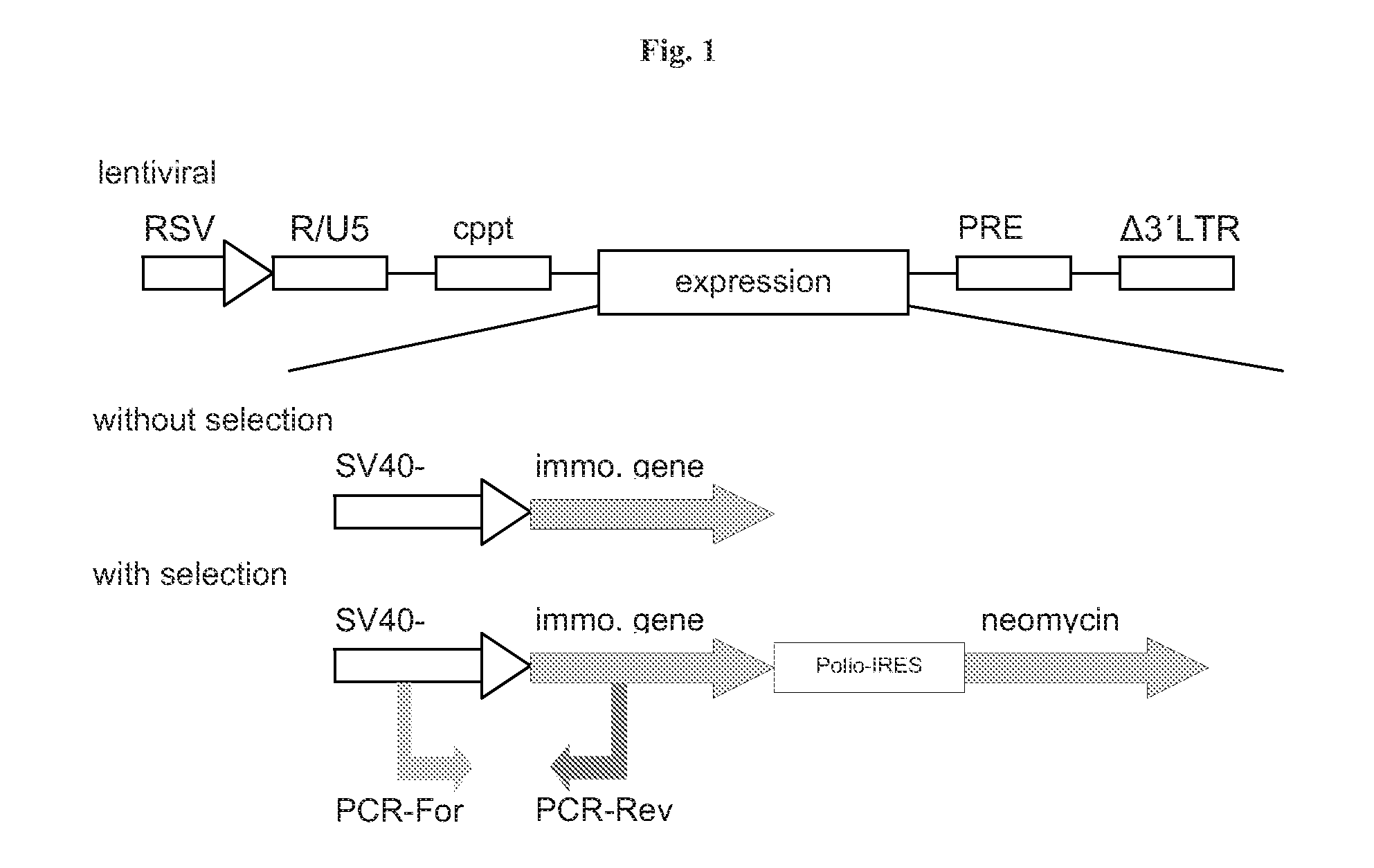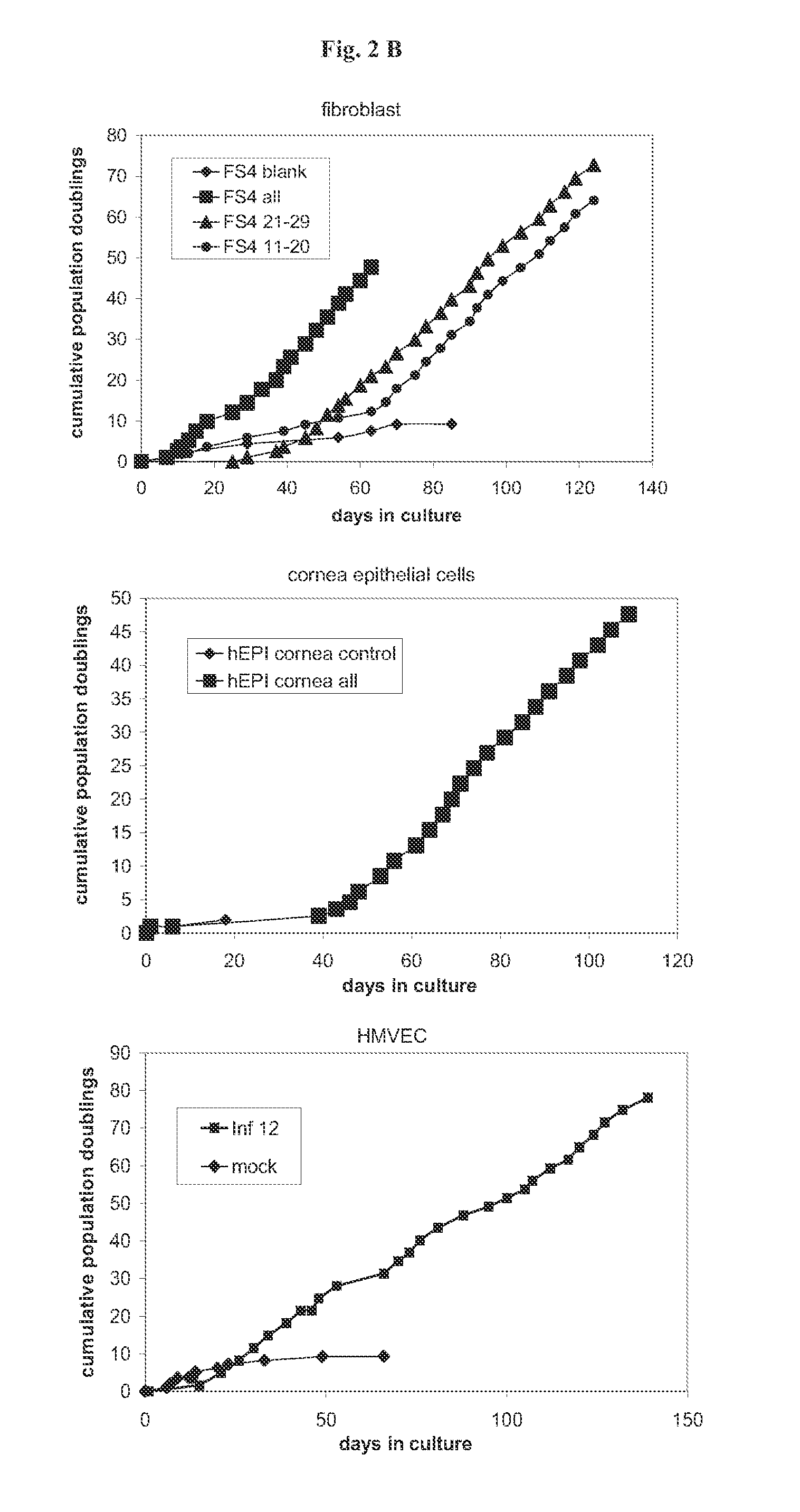Methods and vectors for cell immortalisation
a cell immortalisation and cell technology, applied in the field of cell immortalisation methods and vectors, can solve the problems of insufficient amount of cells, laborious and time-consuming isolation procedures, and lack of biological relevance, and achieve the effect of facilitating the progression of the cell cycl
- Summary
- Abstract
- Description
- Claims
- Application Information
AI Technical Summary
Benefits of technology
Problems solved by technology
Method used
Image
Examples
example 1
Identification of Immortalising Genes
[0172]The aim of the technology of the invention is to provide biologically relevant mammalian cells in unlimited numbers. To solve the limitations of the current process of cell line establishment, we identified 33 different genes that could induce immortalisation of mammalian cells. Included in this set of genes are viral oncogenes, mammalian oncogenes, genes that are overexpressed in tumor cells and genes that inhibit differentiation. The immortalising genes that were employed are listed in table 1 in which the abbreviations are given that are used in this description. In addition the official gene title, geneID and the gene symbol are provided which are taken from the NCBI database as well as the species / organism from which the gene was derived from. The employed cellular genes were either from human or from mouse. However, for the present invention also homologues from other species can be used.
TABLE 1Overview of the employed genesAbbreviati...
example 2
Recombinant Expression of the Immortalising Genes in Primary Cells
[0173]To achieve immortalisation of primary cells, the immortalising genes have to be recombinantly expressed in primary mammalian cells. For this purpose any gene or protein transduction method can be employed that allows recombinant expression of the immortalising genes. Furthermore, any gene expression cassette (whether integrated in the host cell genome or not) that is capable of inducing the expression of the immortalising genes can be employed.
[0174]In the following examples lentiviral particles were used to transduce primary cells and the SV40 promoter was used to drive the expression of the immortalising genes. The lentiviral vectors that were used are third generation self-inactivating lentiviral vectors. In these lentiviral plasmids the viral sequences have been successively reduced. In this vector generation not only the accessory genes vpr, nev, rev and gag / pol are deleted but also the viral LTRs are modif...
example 3
Establishment of Mammalian Cell Systems
[0191]The described technology allows the establishment of novel mammalian cell lines independent of the species, cell type, genotype of the donor, or the age of the donor. For this purpose the primary cells of interest can be transduced with the whole set of 33 immortalising genes or with a suitable smaller subset of immortalising genes. In the following examples the utility of this technology was proven with the establishment of novel mammalian cell lines derived from different species (murine, bovine, human), from different cell types (fibroblasts, bone marrow stroma cells, macrophages, endothelial cells, osteoblasts, chondrocytes, keratinocytes, lung epithelial cells, cornea epithelial cells, hepatocytes), from different genotypes (fibroblasts, bone marrow stroma cells) and from young (human umbilical cord endothelial cells and keratinocytes) and adult (human adult keratinocytes, human adult microvascular endothelial cells) individuals. How...
PUM
| Property | Measurement | Unit |
|---|---|---|
| area | aaaaa | aaaaa |
| volume | aaaaa | aaaaa |
| volume | aaaaa | aaaaa |
Abstract
Description
Claims
Application Information
 Login to View More
Login to View More - R&D
- Intellectual Property
- Life Sciences
- Materials
- Tech Scout
- Unparalleled Data Quality
- Higher Quality Content
- 60% Fewer Hallucinations
Browse by: Latest US Patents, China's latest patents, Technical Efficacy Thesaurus, Application Domain, Technology Topic, Popular Technical Reports.
© 2025 PatSnap. All rights reserved.Legal|Privacy policy|Modern Slavery Act Transparency Statement|Sitemap|About US| Contact US: help@patsnap.com



